Integrating Practice 2 Report: Applying Aseptic Technique in NRSG 140
VerifiedAdded on 2022/10/02
|7
|1242
|26
Report
AI Summary
This report details a nursing student's experience and understanding of aseptic techniques learned in the NRSG 140 course. The student discusses the non-touch technique for wound dressing, initially expressing confusion but later recognizing its importance in preventing infection. The report evaluates the aseptic technique, highlighting its role in minimizing infection risks during and after surgery, particularly when healthcare professionals adhere to all processes. The analysis section contrasts aseptic and cleaning techniques, emphasizing their distinct goals and applications. The student concludes that the chosen technique reduces costs and time, advocating for practical experience to complement theoretical knowledge. The report includes an action plan for future learning, references relevant literature, and emphasizes the importance of linking theory to practice for improved patient outcomes, including the use of aseptic technique audit tools.
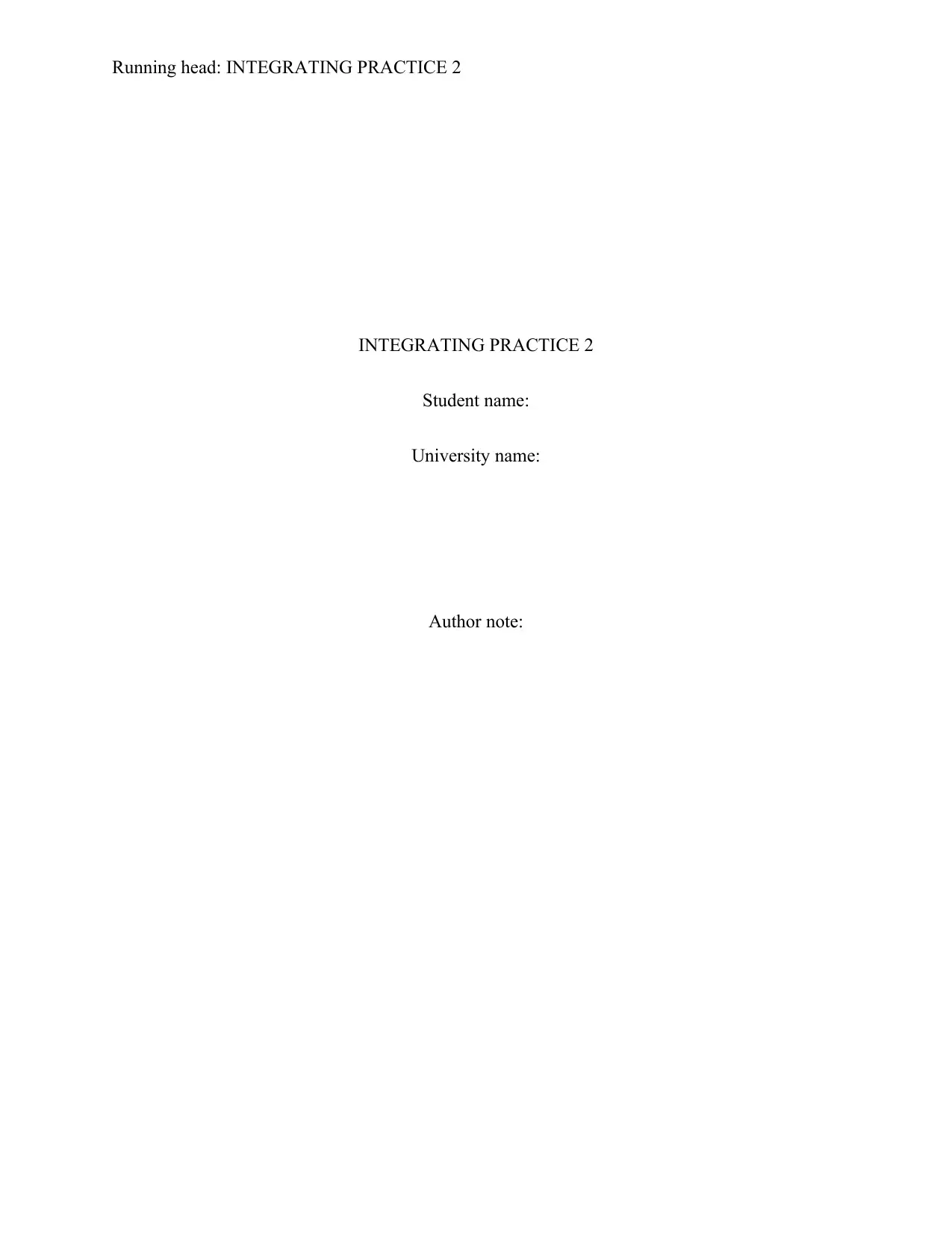
Running head: INTEGRATING PRACTICE 2
INTEGRATING PRACTICE 2
Student name:
University name:
Author note:
INTEGRATING PRACTICE 2
Student name:
University name:
Author note:
Paraphrase This Document
Need a fresh take? Get an instant paraphrase of this document with our AI Paraphraser
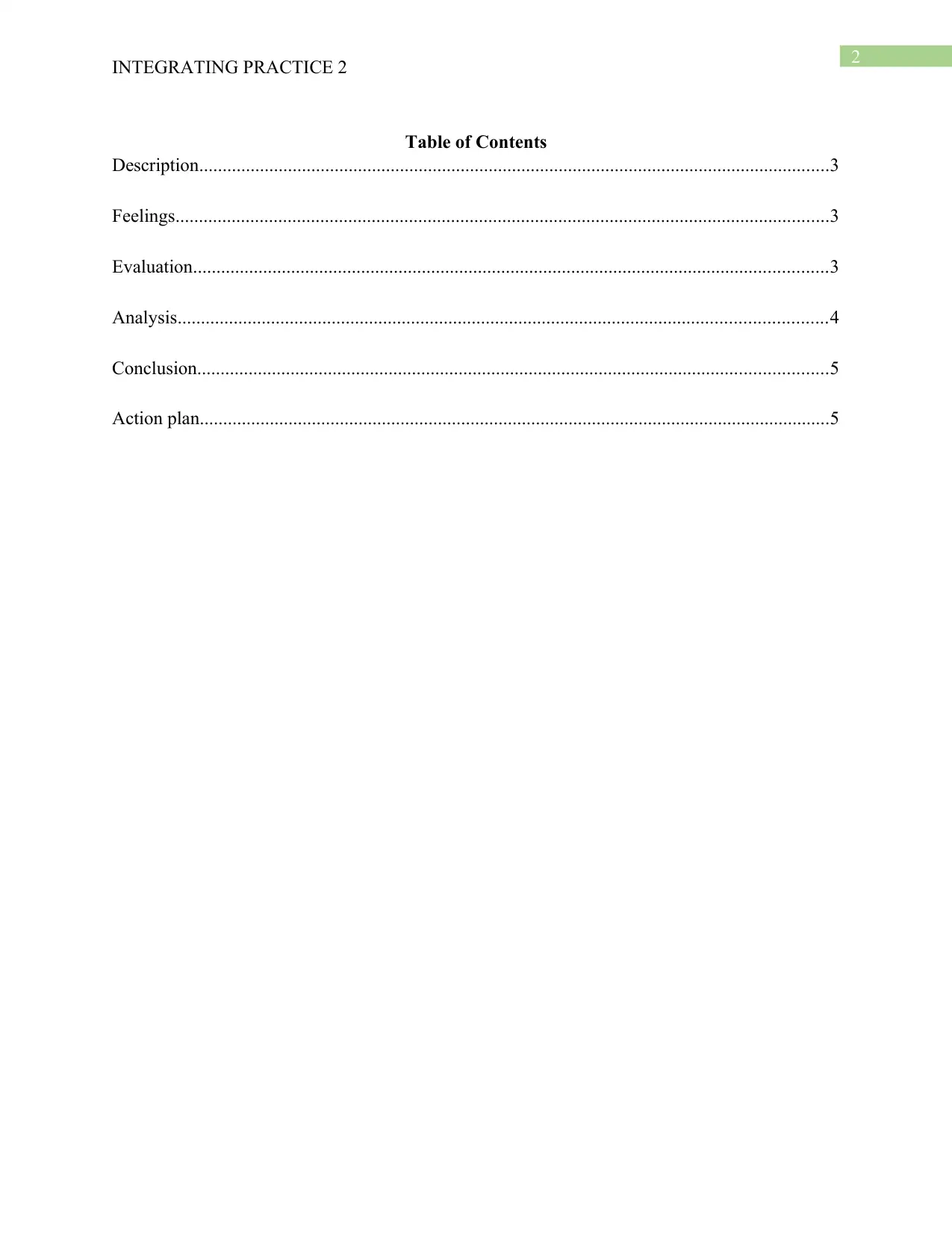
2
INTEGRATING PRACTICE 2
Table of Contents
Description.......................................................................................................................................3
Feelings............................................................................................................................................3
Evaluation........................................................................................................................................3
Analysis...........................................................................................................................................4
Conclusion.......................................................................................................................................5
Action plan.......................................................................................................................................5
INTEGRATING PRACTICE 2
Table of Contents
Description.......................................................................................................................................3
Feelings............................................................................................................................................3
Evaluation........................................................................................................................................3
Analysis...........................................................................................................................................4
Conclusion.......................................................................................................................................5
Action plan.......................................................................................................................................5
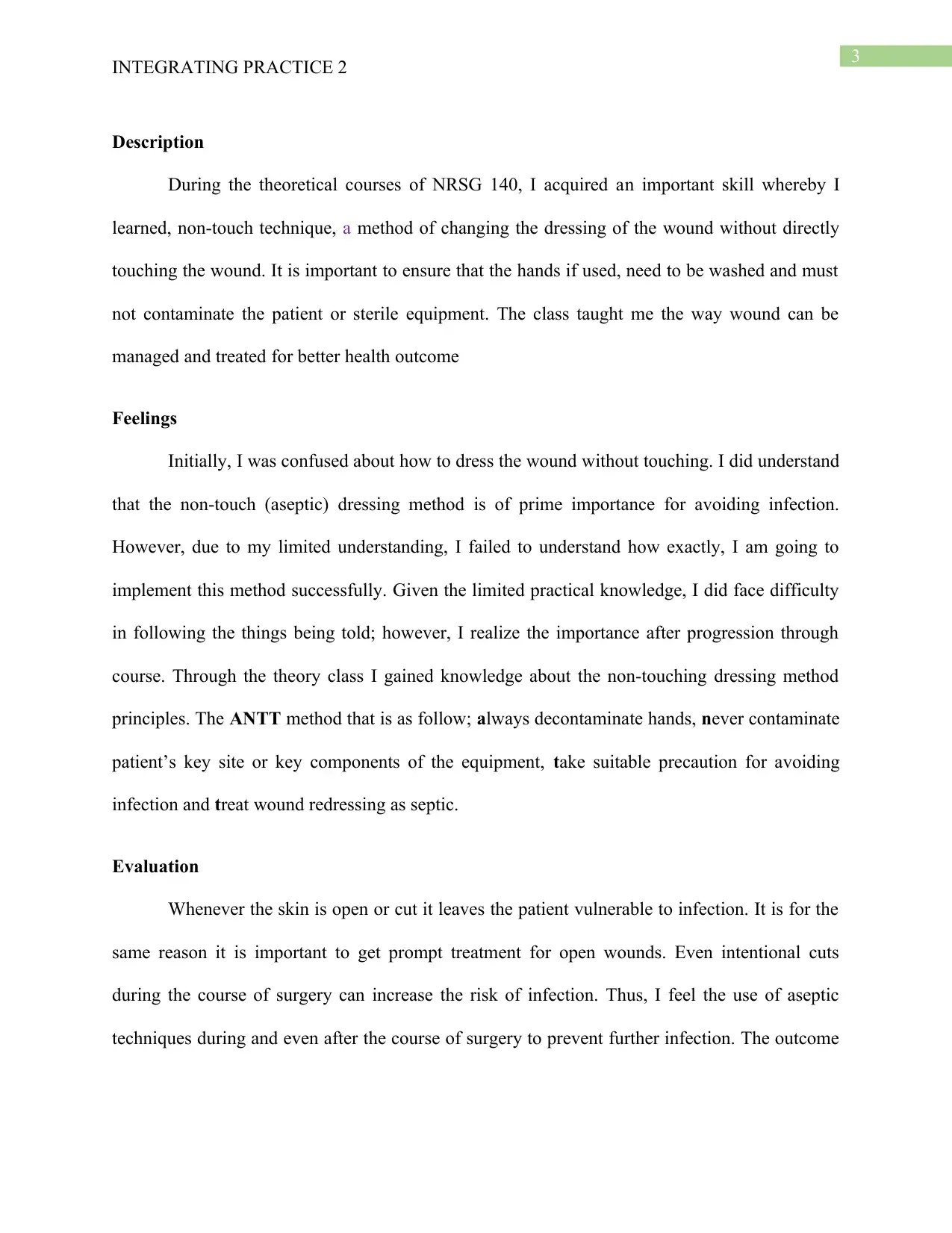
3
INTEGRATING PRACTICE 2
Description
During the theoretical courses of NRSG 140, I acquired an important skill whereby I
learned, non-touch technique, a method of changing the dressing of the wound without directly
touching the wound. It is important to ensure that the hands if used, need to be washed and must
not contaminate the patient or sterile equipment. The class taught me the way wound can be
managed and treated for better health outcome
Feelings
Initially, I was confused about how to dress the wound without touching. I did understand
that the non-touch (aseptic) dressing method is of prime importance for avoiding infection.
However, due to my limited understanding, I failed to understand how exactly, I am going to
implement this method successfully. Given the limited practical knowledge, I did face difficulty
in following the things being told; however, I realize the importance after progression through
course. Through the theory class I gained knowledge about the non-touching dressing method
principles. The ANTT method that is as follow; always decontaminate hands, never contaminate
patient’s key site or key components of the equipment, take suitable precaution for avoiding
infection and treat wound redressing as septic.
Evaluation
Whenever the skin is open or cut it leaves the patient vulnerable to infection. It is for the
same reason it is important to get prompt treatment for open wounds. Even intentional cuts
during the course of surgery can increase the risk of infection. Thus, I feel the use of aseptic
techniques during and even after the course of surgery to prevent further infection. The outcome
INTEGRATING PRACTICE 2
Description
During the theoretical courses of NRSG 140, I acquired an important skill whereby I
learned, non-touch technique, a method of changing the dressing of the wound without directly
touching the wound. It is important to ensure that the hands if used, need to be washed and must
not contaminate the patient or sterile equipment. The class taught me the way wound can be
managed and treated for better health outcome
Feelings
Initially, I was confused about how to dress the wound without touching. I did understand
that the non-touch (aseptic) dressing method is of prime importance for avoiding infection.
However, due to my limited understanding, I failed to understand how exactly, I am going to
implement this method successfully. Given the limited practical knowledge, I did face difficulty
in following the things being told; however, I realize the importance after progression through
course. Through the theory class I gained knowledge about the non-touching dressing method
principles. The ANTT method that is as follow; always decontaminate hands, never contaminate
patient’s key site or key components of the equipment, take suitable precaution for avoiding
infection and treat wound redressing as septic.
Evaluation
Whenever the skin is open or cut it leaves the patient vulnerable to infection. It is for the
same reason it is important to get prompt treatment for open wounds. Even intentional cuts
during the course of surgery can increase the risk of infection. Thus, I feel the use of aseptic
techniques during and even after the course of surgery to prevent further infection. The outcome
⊘ This is a preview!⊘
Do you want full access?
Subscribe today to unlock all pages.

Trusted by 1+ million students worldwide
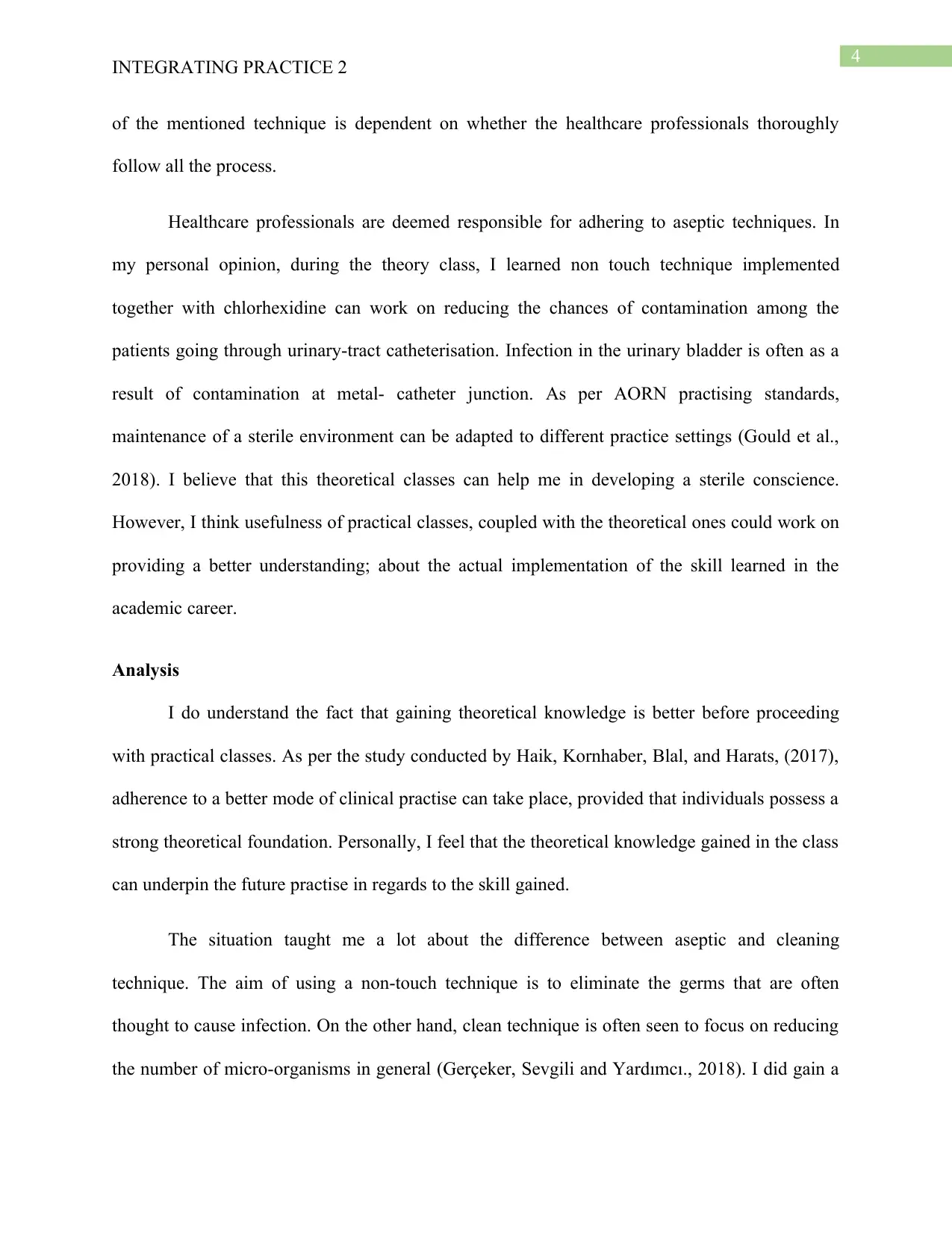
4
INTEGRATING PRACTICE 2
of the mentioned technique is dependent on whether the healthcare professionals thoroughly
follow all the process.
Healthcare professionals are deemed responsible for adhering to aseptic techniques. In
my personal opinion, during the theory class, I learned non touch technique implemented
together with chlorhexidine can work on reducing the chances of contamination among the
patients going through urinary-tract catheterisation. Infection in the urinary bladder is often as a
result of contamination at metal- catheter junction. As per AORN practising standards,
maintenance of a sterile environment can be adapted to different practice settings (Gould et al.,
2018). I believe that this theoretical classes can help me in developing a sterile conscience.
However, I think usefulness of practical classes, coupled with the theoretical ones could work on
providing a better understanding; about the actual implementation of the skill learned in the
academic career.
Analysis
I do understand the fact that gaining theoretical knowledge is better before proceeding
with practical classes. As per the study conducted by Haik, Kornhaber, Blal, and Harats, (2017),
adherence to a better mode of clinical practise can take place, provided that individuals possess a
strong theoretical foundation. Personally, I feel that the theoretical knowledge gained in the class
can underpin the future practise in regards to the skill gained.
The situation taught me a lot about the difference between aseptic and cleaning
technique. The aim of using a non-touch technique is to eliminate the germs that are often
thought to cause infection. On the other hand, clean technique is often seen to focus on reducing
the number of micro-organisms in general (Gerçeker, Sevgili and Yardımcı., 2018). I did gain a
INTEGRATING PRACTICE 2
of the mentioned technique is dependent on whether the healthcare professionals thoroughly
follow all the process.
Healthcare professionals are deemed responsible for adhering to aseptic techniques. In
my personal opinion, during the theory class, I learned non touch technique implemented
together with chlorhexidine can work on reducing the chances of contamination among the
patients going through urinary-tract catheterisation. Infection in the urinary bladder is often as a
result of contamination at metal- catheter junction. As per AORN practising standards,
maintenance of a sterile environment can be adapted to different practice settings (Gould et al.,
2018). I believe that this theoretical classes can help me in developing a sterile conscience.
However, I think usefulness of practical classes, coupled with the theoretical ones could work on
providing a better understanding; about the actual implementation of the skill learned in the
academic career.
Analysis
I do understand the fact that gaining theoretical knowledge is better before proceeding
with practical classes. As per the study conducted by Haik, Kornhaber, Blal, and Harats, (2017),
adherence to a better mode of clinical practise can take place, provided that individuals possess a
strong theoretical foundation. Personally, I feel that the theoretical knowledge gained in the class
can underpin the future practise in regards to the skill gained.
The situation taught me a lot about the difference between aseptic and cleaning
technique. The aim of using a non-touch technique is to eliminate the germs that are often
thought to cause infection. On the other hand, clean technique is often seen to focus on reducing
the number of micro-organisms in general (Gerçeker, Sevgili and Yardımcı., 2018). I did gain a
Paraphrase This Document
Need a fresh take? Get an instant paraphrase of this document with our AI Paraphraser
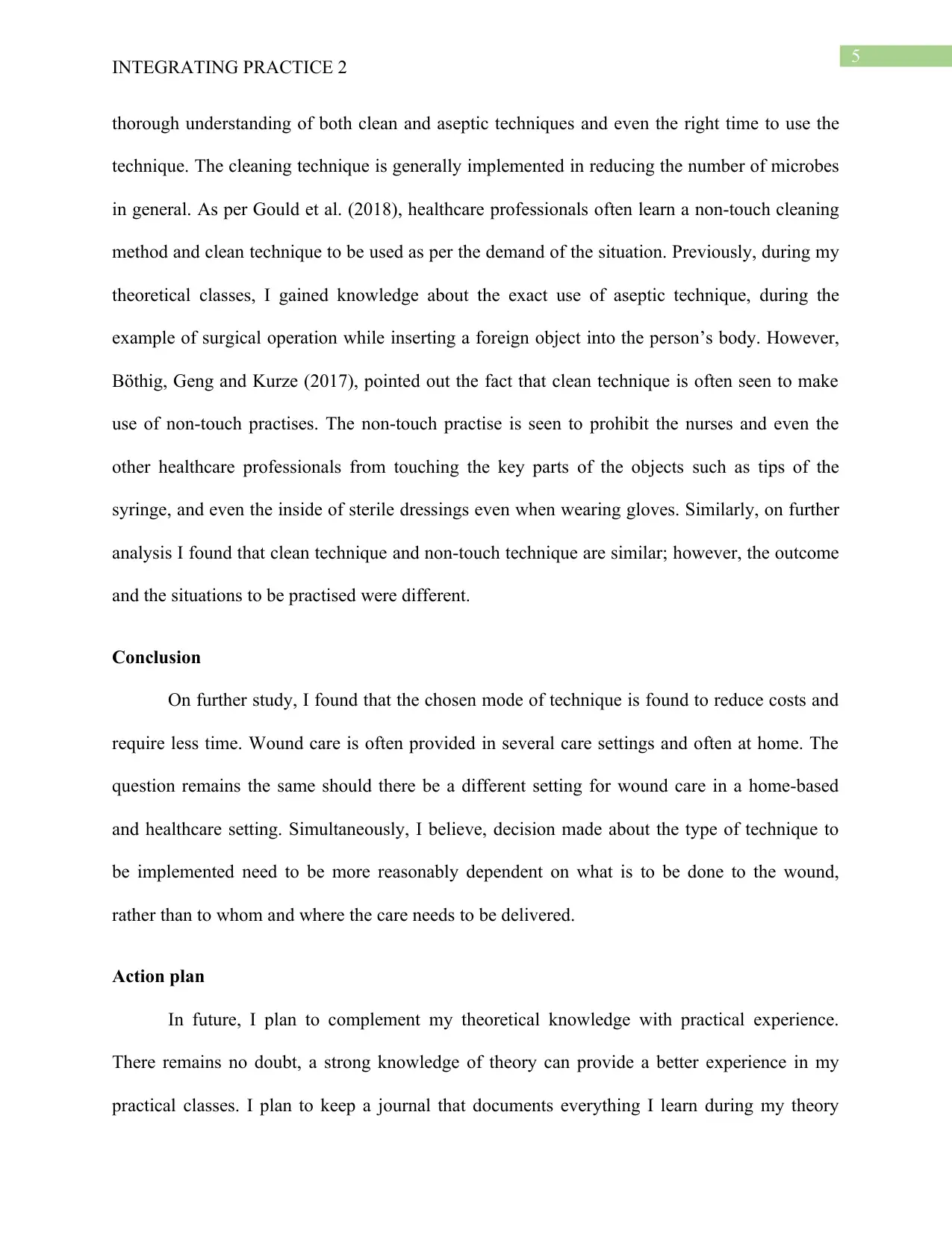
5
INTEGRATING PRACTICE 2
thorough understanding of both clean and aseptic techniques and even the right time to use the
technique. The cleaning technique is generally implemented in reducing the number of microbes
in general. As per Gould et al. (2018), healthcare professionals often learn a non-touch cleaning
method and clean technique to be used as per the demand of the situation. Previously, during my
theoretical classes, I gained knowledge about the exact use of aseptic technique, during the
example of surgical operation while inserting a foreign object into the person’s body. However,
Böthig, Geng and Kurze (2017), pointed out the fact that clean technique is often seen to make
use of non-touch practises. The non-touch practise is seen to prohibit the nurses and even the
other healthcare professionals from touching the key parts of the objects such as tips of the
syringe, and even the inside of sterile dressings even when wearing gloves. Similarly, on further
analysis I found that clean technique and non-touch technique are similar; however, the outcome
and the situations to be practised were different.
Conclusion
On further study, I found that the chosen mode of technique is found to reduce costs and
require less time. Wound care is often provided in several care settings and often at home. The
question remains the same should there be a different setting for wound care in a home-based
and healthcare setting. Simultaneously, I believe, decision made about the type of technique to
be implemented need to be more reasonably dependent on what is to be done to the wound,
rather than to whom and where the care needs to be delivered.
Action plan
In future, I plan to complement my theoretical knowledge with practical experience.
There remains no doubt, a strong knowledge of theory can provide a better experience in my
practical classes. I plan to keep a journal that documents everything I learn during my theory
INTEGRATING PRACTICE 2
thorough understanding of both clean and aseptic techniques and even the right time to use the
technique. The cleaning technique is generally implemented in reducing the number of microbes
in general. As per Gould et al. (2018), healthcare professionals often learn a non-touch cleaning
method and clean technique to be used as per the demand of the situation. Previously, during my
theoretical classes, I gained knowledge about the exact use of aseptic technique, during the
example of surgical operation while inserting a foreign object into the person’s body. However,
Böthig, Geng and Kurze (2017), pointed out the fact that clean technique is often seen to make
use of non-touch practises. The non-touch practise is seen to prohibit the nurses and even the
other healthcare professionals from touching the key parts of the objects such as tips of the
syringe, and even the inside of sterile dressings even when wearing gloves. Similarly, on further
analysis I found that clean technique and non-touch technique are similar; however, the outcome
and the situations to be practised were different.
Conclusion
On further study, I found that the chosen mode of technique is found to reduce costs and
require less time. Wound care is often provided in several care settings and often at home. The
question remains the same should there be a different setting for wound care in a home-based
and healthcare setting. Simultaneously, I believe, decision made about the type of technique to
be implemented need to be more reasonably dependent on what is to be done to the wound,
rather than to whom and where the care needs to be delivered.
Action plan
In future, I plan to complement my theoretical knowledge with practical experience.
There remains no doubt, a strong knowledge of theory can provide a better experience in my
practical classes. I plan to keep a journal that documents everything I learn during my theory
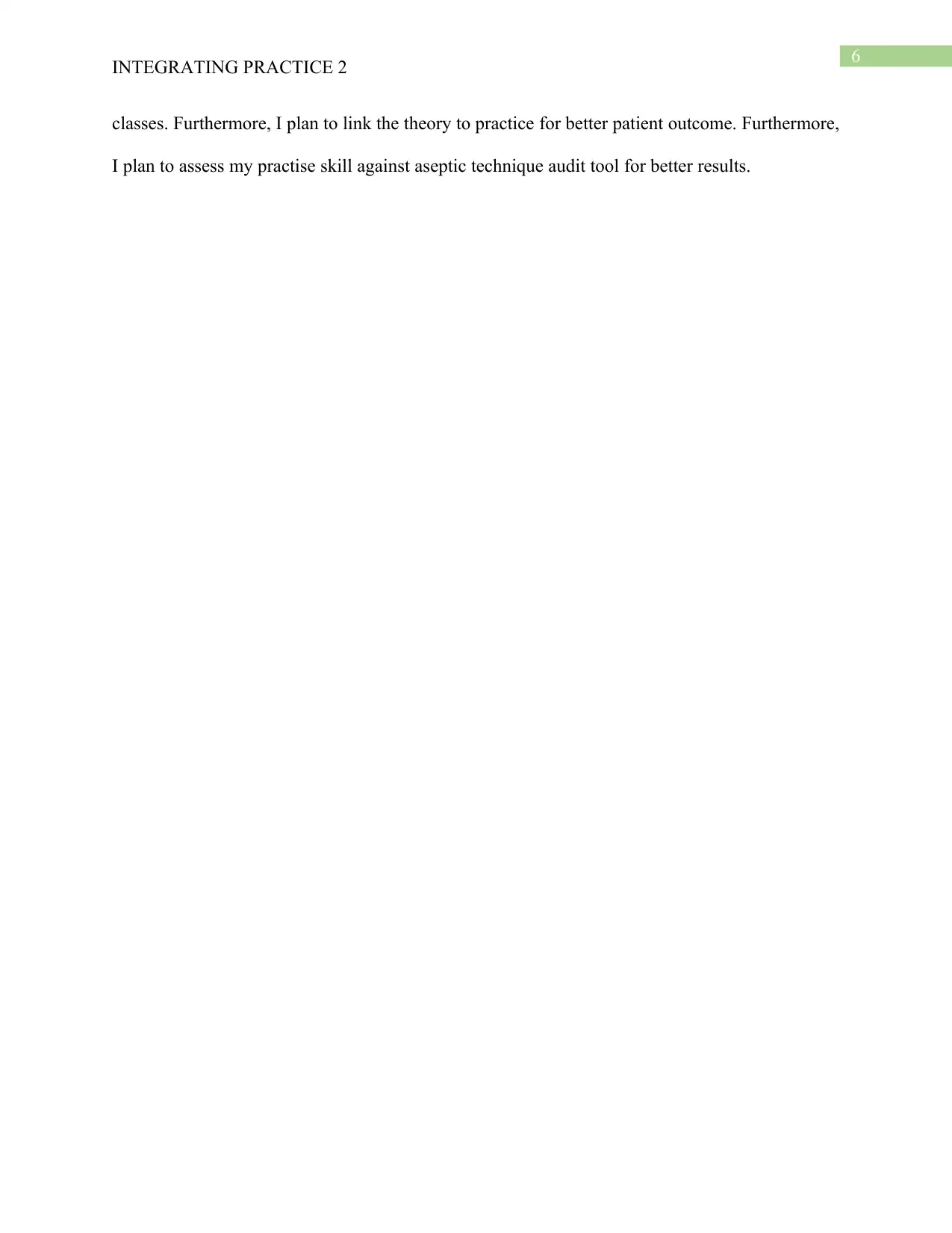
6
INTEGRATING PRACTICE 2
classes. Furthermore, I plan to link the theory to practice for better patient outcome. Furthermore,
I plan to assess my practise skill against aseptic technique audit tool for better results.
INTEGRATING PRACTICE 2
classes. Furthermore, I plan to link the theory to practice for better patient outcome. Furthermore,
I plan to assess my practise skill against aseptic technique audit tool for better results.
⊘ This is a preview!⊘
Do you want full access?
Subscribe today to unlock all pages.

Trusted by 1+ million students worldwide
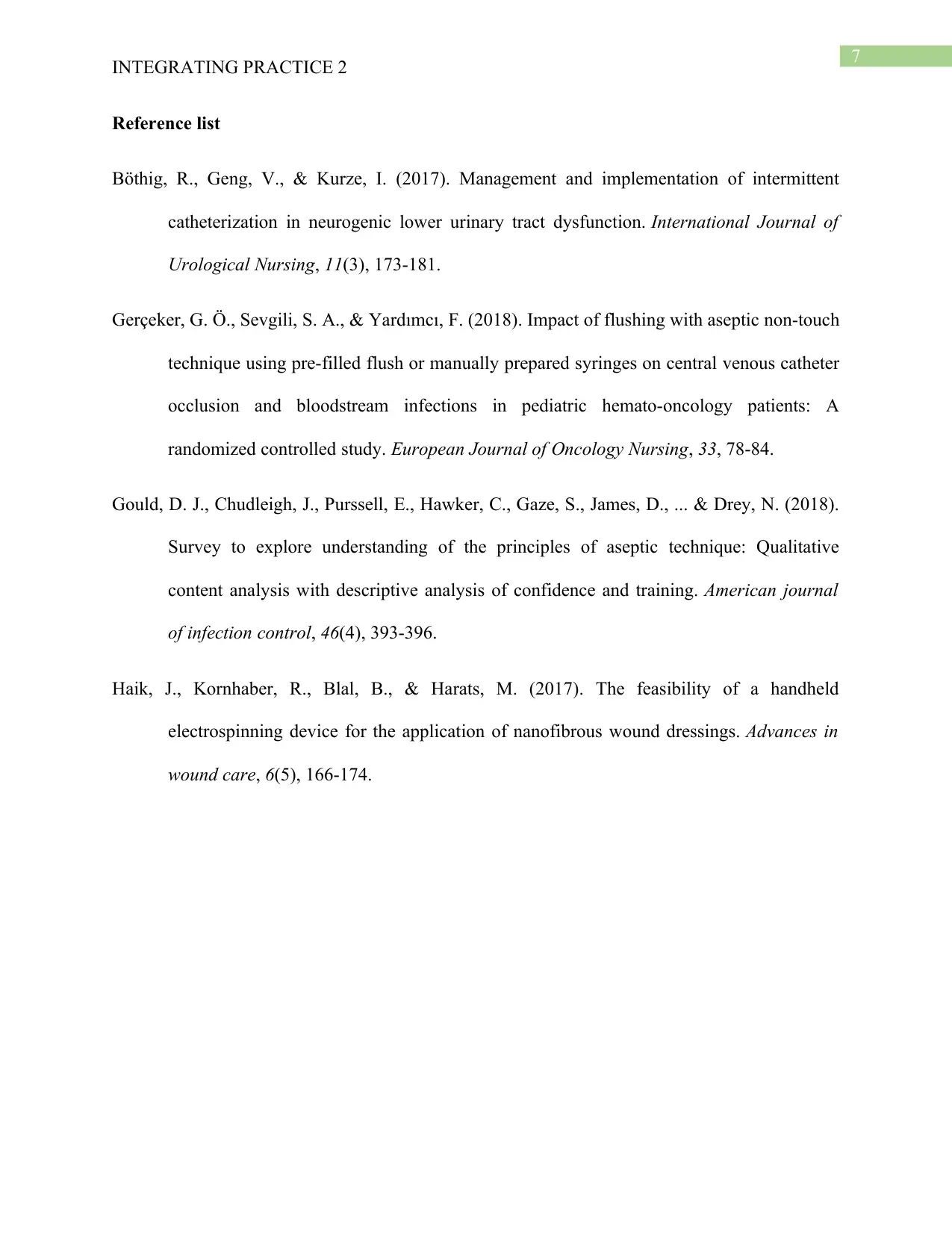
7
INTEGRATING PRACTICE 2
Reference list
Böthig, R., Geng, V., & Kurze, I. (2017). Management and implementation of intermittent
catheterization in neurogenic lower urinary tract dysfunction. International Journal of
Urological Nursing, 11(3), 173-181.
Gerçeker, G. Ö., Sevgili, S. A., & Yardımcı, F. (2018). Impact of flushing with aseptic non-touch
technique using pre-filled flush or manually prepared syringes on central venous catheter
occlusion and bloodstream infections in pediatric hemato-oncology patients: A
randomized controlled study. European Journal of Oncology Nursing, 33, 78-84.
Gould, D. J., Chudleigh, J., Purssell, E., Hawker, C., Gaze, S., James, D., ... & Drey, N. (2018).
Survey to explore understanding of the principles of aseptic technique: Qualitative
content analysis with descriptive analysis of confidence and training. American journal
of infection control, 46(4), 393-396.
Haik, J., Kornhaber, R., Blal, B., & Harats, M. (2017). The feasibility of a handheld
electrospinning device for the application of nanofibrous wound dressings. Advances in
wound care, 6(5), 166-174.
INTEGRATING PRACTICE 2
Reference list
Böthig, R., Geng, V., & Kurze, I. (2017). Management and implementation of intermittent
catheterization in neurogenic lower urinary tract dysfunction. International Journal of
Urological Nursing, 11(3), 173-181.
Gerçeker, G. Ö., Sevgili, S. A., & Yardımcı, F. (2018). Impact of flushing with aseptic non-touch
technique using pre-filled flush or manually prepared syringes on central venous catheter
occlusion and bloodstream infections in pediatric hemato-oncology patients: A
randomized controlled study. European Journal of Oncology Nursing, 33, 78-84.
Gould, D. J., Chudleigh, J., Purssell, E., Hawker, C., Gaze, S., James, D., ... & Drey, N. (2018).
Survey to explore understanding of the principles of aseptic technique: Qualitative
content analysis with descriptive analysis of confidence and training. American journal
of infection control, 46(4), 393-396.
Haik, J., Kornhaber, R., Blal, B., & Harats, M. (2017). The feasibility of a handheld
electrospinning device for the application of nanofibrous wound dressings. Advances in
wound care, 6(5), 166-174.
1 out of 7
Related Documents
Your All-in-One AI-Powered Toolkit for Academic Success.
+13062052269
info@desklib.com
Available 24*7 on WhatsApp / Email
![[object Object]](/_next/static/media/star-bottom.7253800d.svg)
Unlock your academic potential
Copyright © 2020–2025 A2Z Services. All Rights Reserved. Developed and managed by ZUCOL.



